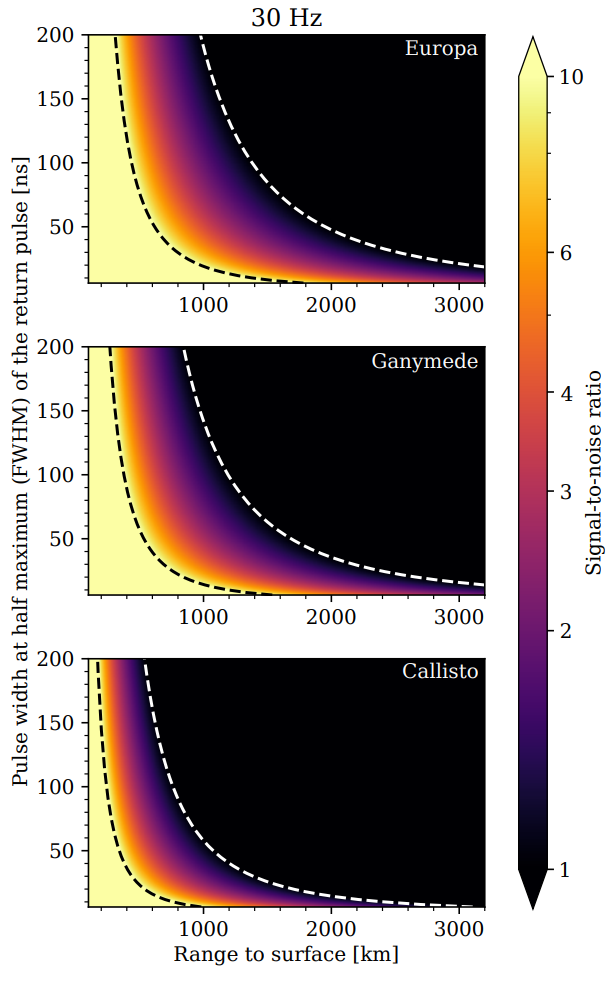Performance of the Ganymede Laser Altimeter (GALA) based on cruise measurements
- 1DLR, Department of Planetary Geodesy, Berlin, Germany (alexander.stark@dlr.de)
- 2University of Nantes, Nantes, France
- 3JAXA, ISAS, Japan
- 4University of Sao Paulo, Sao Paulo, Brazil
- 5Osaka University, Osaka, Japan
- 6Technical University Berlin, Berlin, Germany
- 7Istituto di Astrofisica e Planetologia Spaziali - Istituto Nazionale di Astrofisica, Rom, Italy
- 8IPGP, Paris, France
- *A full list of authors appears at the end of the abstract
The Ganymede Laser Altimeter (GALA) on board the Jupiter Icy Moons Explorer (JUICE) is currently on its way to its targets, the Galilean Moons. Following the launch of the mission in April 14th 2023 the instruments on board have been checked for functionality and performance. While these regular checkouts were performed in cruise, the upcoming flyby at Earth’s Moon will give a unique opportunity to receive ground returns, assess ranging performance, and calibrate the instrument.
GALA is an active instrument emitting short laser pulses (about 5 ns) of infrared radiation (at 1064 nm) to its target. Nominally, GALA emits 30 shots per second with a pulse energy of 17 mJ and a pulse divergence of 100 µrad (full cone). The receiver collects a small fraction of the reflected laser light and the round-trip travel time of the pulse is measured by the instrument electronics. In contrast to previous planetary laser altimeters, GALA features a high-frequency (200 MHz) temporal sampling of the return pulse. This enhances significantly the precision of range measurements and allows a reliable estimate of the surface roughness and albedo at the footprint scale. Performance estimates based on dark-noise measurements in cruise checkouts and models of surface properties suggest a maximal ranging distance of 1400 km for Ganymede, 1600 km for Europa, and 1100 km for Callisto. At these distances the signal-to-noise ratio for a large fraction of possible return pulse widths is larger than 1, which comprises the detection limit for GALA (see Figure 1).
Current performance estimates of GALA will come to a powerful test at the lunar flyby, where measurement conditions are challenging: (1) the range to the lunar surface is above 800 km; (2) observation geometries are at an oblique angle due to the fixed inertial pointing of JUICE and (3) the albedo of the lunar surface, in particular the mare areas, is lower than on the icy satellites. Despite these challenges, current modelling suggests that GALA will be able to obtain a topographic profile of the lunar surface, which will be used to calibrate, in particular, GALA’s albedo measurement and the orientation of the transmitter boresight vector. The latter will be also determined by a cross-calibration to the JANUS camera on JUICE using data from the night side. For that purpose, JANUS will take long-exposure images during GALA operation. With that procedure it is expected to precisely locate GALA’s footprint in the detector of JANUS and thus to precisely constrain the relative orientation of the boresight vectors of the two instruments.

Figure 1: Signal-to-noise ratio (SNR) for GALA at Europa (top), Ganymede (middle) and Callisto (bottom). The black dashed line shows SNR values of 10 and the dashed white line an SNR of 1.
GALA Co-Is and associates
How to cite: Stark, A., Hussmann, H., Althaus, C., Behnke, T., Binger, J., Choblet, G., Enya, K., Ferraz Mello, S., George, J. P., Hüttig, C., Kimura, J., Lingenauber, K., Nishiyama, G., Oberst, J., Palumbo, P., Portyankina, G., Tubiana, C., Wickhusen, K., Willner, K., and Wieczorek, M. and the GALA team: Performance of the Ganymede Laser Altimeter (GALA) based on cruise measurements, Europlanet Science Congress 2024, Berlin, Germany, 8–13 Sep 2024, EPSC2024-871, https://doi.org/10.5194/epsc2024-871, 2024.